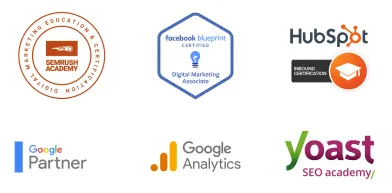TO LEARN IS TO GROW
Learning Center
We do our research and publish our results. Should probably call this the Growing Center.


Signs You Should Invest In Marketing
There are so many questions when it comes to Marketing. Do I need it? Why would I need it? Will I get a ROI? How do I know if it’s the right decision for me? Well you’re not alone. Most companies struggle with what type of marketing will work the best for their company.
The most common type of marketing is often called Inbound Marketing. Inbound marketing is an approach focused on attracting customers through content and interactions that are relevant and helpful — not interruptive. With inbound marketing, potential customers find you through channels like blogs, search engines, and social media. Nearly 85% of marketing and communications professionals worldwide are expected to launch at least one type of marketing campaign in the next 12 months and over 80% of marketers who had launched marketing campaigns involving social media influencers found them to be effective for driving both engagement and awareness.
Unlike outbound marketing, inbound marketing does not need to fight for a potential customer’s attention. By creating content designed to address the problems and needs of your ideal customers, inbound marketing attracts compatible prospects and builds trust and credibility for your business.
Want to know if you are ready for Inbound Marketing? Lets look at a few different situations that might arise in your business:
Situation 1: You are launching a new product or service. Using Inbound Marketing you can target specific people that would be interested in and actually use your product. The worst thing you could do is waste resources advertising your product or company to people that would never use your products or be interested in any type of service you offer.
Situation 2: Your advertising is not providing the return you need. If you aren’t getting the return on your investments with advertising, then you aren’t doing it right. Inbound Marketing helps you to target a specific type of customer that guarantees a return.
Situation 3: You don’t know why you are losing customers. If you are losing customers and you’re not sure why, marketing can help to figure that out. A quick Voice of Customer (VoC) email survey will get you the answers you need to start making any corrections necessary. This will provide you with objective data directly from your customers so you can start making changes and stop losing customers.
Situation 4: Your competitors are doing it. It is almost a guarantee that your competitors are using some form of marketing, so you should be too. Companies who apply marketing in their business plan create a competitive edge in their market. In most cases you can bet that whoever knows the customer best, wins. But they also know who to market to, how to market to them, and when to market to them.
Situation 5: Your content marketing has gone stale. Sometimes you need to revamp your marketing strategy to get people noticing you again. Changing things up and staying current with the time and trends is a perfect way to keep your client base coming back for more time and time again.
Sign 6: You haven’t invested heavily in digital/social media. With the continued growth of mobile usage, e-commerce, and shoppers’ embracing of technology to make purchase decisions, it’s critical for brands to have a mobile and social strategy in place.
Sign 7: You’re not driving enough sales during key selling periods. By publishing the right content in the right place at the right time, your marketing becomes relevant and helpful to your customers, not interruptive.
If any of these situations are happening in your business, then it would be wise to invest in a form of marketing that can help drive customers to you and build your customer base.
Written by Kim Ganir

Signs You Should Invest In Marketing
There are so many questions when it comes to Marketing. Do I need it? Why would I need it? Will I get a ROI? How do I know if it’s the right decision for me? Well you’re not alone. Most companies struggle with what type of marketing will work the best for their company.
The most common type of marketing is often called Inbound Marketing. Inbound marketing is an approach focused on attracting customers through content and interactions that are relevant and helpful — not interruptive. With inbound marketing, potential customers find you through channels like blogs, search engines, and social media. Nearly 85% of marketing and communications professionals worldwide are expected to launch at least one type of marketing campaign in the next 12 months and over 80% of marketers who had launched marketing campaigns involving social media influencers found them to be effective for driving both engagement and awareness.
Unlike outbound marketing, inbound marketing does not need to fight for a potential customer’s attention. By creating content designed to address the problems and needs of your ideal customers, inbound marketing attracts compatible prospects and builds trust and credibility for your business.
Want to know if you are ready for Inbound Marketing? Lets look at a few different situations that might arise in your business:
Situation 1: You are launching a new product or service. Using Inbound Marketing you can target specific people that would be interested in and actually use your product. The worst thing you could do is waste resources advertising your product or company to people that would never use your products or be interested in any type of service you offer.
Situation 2: Your advertising is not providing the return you need. If you aren’t getting the return on your investments with advertising, then you aren’t doing it right. Inbound Marketing helps you to target a specific type of customer that guarantees a return.
Situation 3: You don’t know why you are losing customers. If you are losing customers and you’re not sure why, marketing can help to figure that out. A quick Voice of Customer (VoC) email survey will get you the answers you need to start making any corrections necessary. This will provide you with objective data directly from your customers so you can start making changes and stop losing customers.
Situation 4: Your competitors are doing it. It is almost a guarantee that your competitors are using some form of marketing, so you should be too. Companies who apply marketing in their business plan create a competitive edge in their market. In most cases you can bet that whoever knows the customer best, wins. But they also know who to market to, how to market to them, and when to market to them.
Situation 5: Your content marketing has gone stale. Sometimes you need to revamp your marketing strategy to get people noticing you again. Changing things up and staying current with the time and trends is a perfect way to keep your client base coming back for more time and time again.
Sign 6: You haven’t invested heavily in digital/social media. With the continued growth of mobile usage, e-commerce, and shoppers’ embracing of technology to make purchase decisions, it’s critical for brands to have a mobile and social strategy in place.
Sign 7: You’re not driving enough sales during key selling periods. By publishing the right content in the right place at the right time, your marketing becomes relevant and helpful to your customers, not interruptive.
If any of these situations are happening in your business, then it would be wise to invest in a form of marketing that can help drive customers to you and build your customer base.
Written by Kim Ganir
Growing Businesses Since 2008
We have helped hundreds of businesses just like yours. Working for or along-side of business owner, managers, staff, or even board of directors, LOJO is ready to be an asset to your business.
Our team has been curated through the years for individual skills, personalities, and capabilities. Our clients put their trust in us to help them grow. We are here to do just that.



Growing Businesses Since 2008
We have helped hundreds of businesses just like yours. Working for or along-side of business owner, managers, staff, or even board of directors, LOJO is ready to be an asset to your business.
Our team has been curated through the years for individual skills, personalities, and capabilities. Our clients put their trust in us to help them grow. We are here to do just that.




Matthew Rogers, President
iProspect Check
After spending several months reviewing multiple proposals from several different companies we engaged LOJO to develop a new website that represents our company effectively. We worked initially with Stephen Platte who helped create the scope of the project. Stephen was knowledgeable and always followed up with me on time and as promised.
He "closed the deal" for LOJO with his professionalism, service orientation and easy going approach. Once we signed the contract we were introduced to Jay Kelly who would be the creative lead for LOJO. This was the most challenging part of the project for my company, as there was no shortage of ideas from our side. Jay managed the project flawlessly, and once we had all agreed to the design, Jay introduced us to Eric.
Eric Lay is one of the founders of LOJO. Eric took the design we had developed and brought it to life. We delivered content as quickly as he requested it. Eric kept the project on task and we responded by exceeding every deadline for content. In turn, once provided, literally not a day went by that Eric didn't add the content and take the next step. In just a few weeks we launched our new website. Eric is a pleasure to work with.
His positive attitude and consultative approach really enhanced the experience and made a big difference for us in the outcome of our project. We would welcome you to visit our website to take a look at the quality work of LOJO. We are very pleased with LOJO and look forward to working with them in the future as we pursue an aggressive SEO strategy."
After spending several months reviewing multiple proposals from several different companies we engaged LOJO to develop a new website that represents our company effectively. We worked initially with Stephen Platte who helped create the scope of the project. Stephen was knowledgeable and always followed up with me on time and as promised.
He "closed the deal" for LOJO with his professionalism, service orientation and easy going approach. Once we signed the contract we were introduced to Jay Kelly who would be the creative lead for LOJO. This was the most challenging part of the project for my company, as there was no shortage of ideas from our side. Jay managed the project flawlessly, and once we had all agreed to the design, Jay introduced us to Eric.
Eric Lay is one of the founders of LOJO. Eric took the design we had developed and brought it to life. We delivered content as quickly as he requested it. Eric kept the project on task and we responded by exceeding every deadline for content. In turn, once provided, literally not a day went by that Eric didn't add the content and take the next step. In just a few weeks we launched our new website. Eric is a pleasure to work with.
His positive attitude and consultative approach really enhanced the experience and made a big difference for us in the outcome of our project. We would welcome you to visit our website to take a look at the quality work of LOJO. We are very pleased with LOJO and look forward to working with them in the future as we pursue an aggressive SEO strategy."

Matthew Rogers, President
iProspect Check
The team at LOJO were wonderful to work with. They are well organized and very patient as we worked through our marketing strategy and developed a well thought out and clear action plan at a reasonable price. We will definitely be back for our future campaign needs."

Jon Crosby, Founder
Dazil

